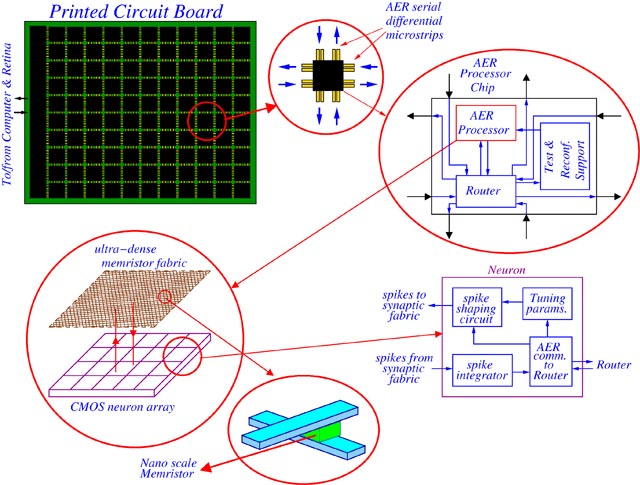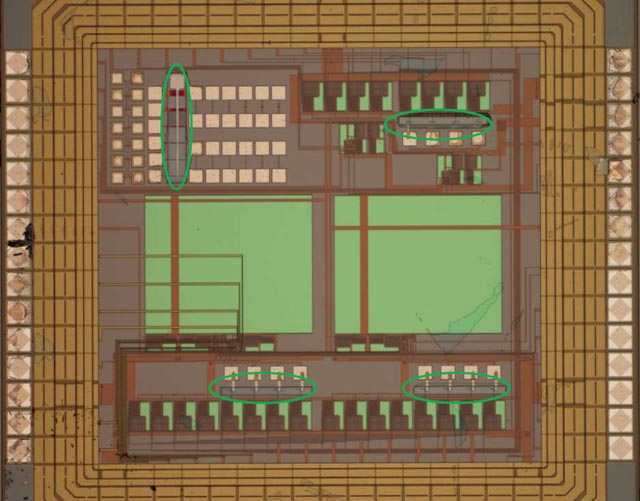

Nanoelectronics and Emerging Technologies
With the end of Moore's Law approaching quickly, mainstream CMOS downscaling is slowing down. Novel nanoscale emerging devices compatible with CMOS fabrication technologies promise to overcome this slow down. Ultra-dense multi-layer fabrics of nano-scale devices can be fabricated as BEOL (back end of line) on top of CMOS substrates. One of these emerging devices are memristors, also called resistive-RAM (RRAM), which are two-terminal devices whose resistance can be changed as the devices are stimulated differently. Some of these memristors allow for two-state resistances, while other less developed may allow for continuous non-volatile analog memory states. In this research line our main focus is to exploit these novel memristive devices combined with optimized CMOS circuits to provide ultra-compact ultra-low-power computing architectures for edge and IoT applications.
Main recent activities in this line include:


Bernabé Linares Barranco< >
Google Scholar
Teresa Serrano Gotarredona< >
Google Scholar
Luis A. Camuñas Mesa< >
Google Scholar
L. A. Camuñas-Mesa, B. Linares-Barranco and T. Serrano-Gotarredona, "Neuromorphic Spiking Neural Networks and Their Memristor-CMOS Hardware Implementations", Materials, vol. 12, no. 7, article 2745, 2019 » doi
B. Linares-Barranco, "Memristors fire away", Nature Electronics, vol. 1, no. 2, pp 100-101, 2018 » doi
X. Guo, F. Merrikh-Bayat, L. Gao, B.D. Hoskins, F. Alibart, B. Linares-Barranco, L. Theogarajan, C. Teuscher and D.B. Strukov, "Modeling and Experimental Demonstration of a Hopfield Network Analog-to-Digital Converter with Hybrid CMOS/Memristor Circuits", Frontiers in Neuromorphic Engineering, Frontiers in Neuroscience, vol. 9, article 488, 2015 » doi
G. Indiveri, B. Linares-Barranco, R. Legenstein, G. Deligeorgis and T. Prodromakis, "Integration of nanoscale memristor synapses in neuromorphic computing architectures", Nanotechnology, vol. 24, no. 38, article 384010, 2013 » doi
C. Zamarreño-Ramos, L. A. Camuñas-Mesa, J.A. Perez-Carrasco, T. Masquelier, T. Serrano-Gotarredona and B. Linares-Barranco, "On Spike-Timing-Dependent-Plasticity, Memristive Devices, and building a Self-Learning Visual Cortex", Frontiers in Neuromorphic Engineering, Frontiers in Neuroscience, vol. 5, article 26, 2011 » doi
Nano-Mind: Neuromorphic Perception and Nano-Memristive Cognition for High-Speed Robotic Actuation
PI: Teresa Serrano Gotarredona
Funding Body: Min. de Ciencia e Innovación
Jun 2020 - May 2024
MeM-Scales: Memory technologies with multi-scale time constants for neuromorphic architectures
PI: Bernabé Linares Barranco
Funding Body: European Union
Jan 2020 - Dec 2022
HERMES: Hybrid Enhanced Regenerative Medicine Systems
PI: Teresa Serrano Gotarredona
Funding Body: European Union
Jan 2019 - Dec 2022
NeuRAM3: NEUral computing aRchitectures in Advanced Monolithic 3D-VLSI nano-technologies
PI: Teresa Serrano Gotarredona
Funding Body: European Union
Jan 2016 - Jun 2019
WEBSITE
MemoCiS: Memristors - Devices, Models, Circuits, Systems and Applications
PI: Bernabé Linares Barranco
Funding Body: COST Action IC1401
May 2014 - May 2018